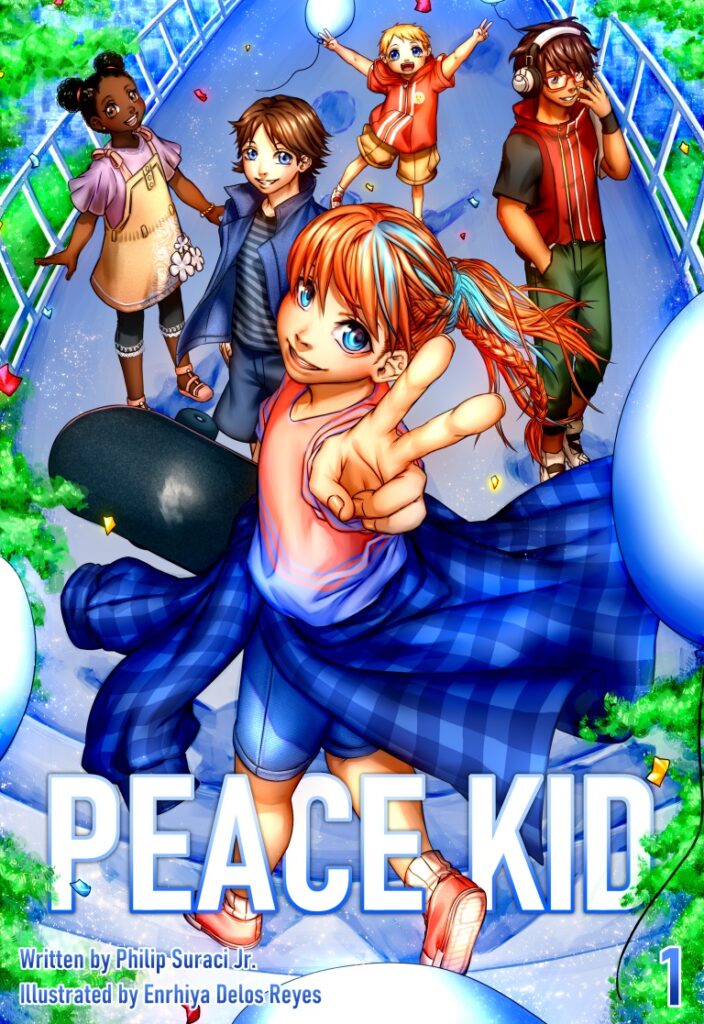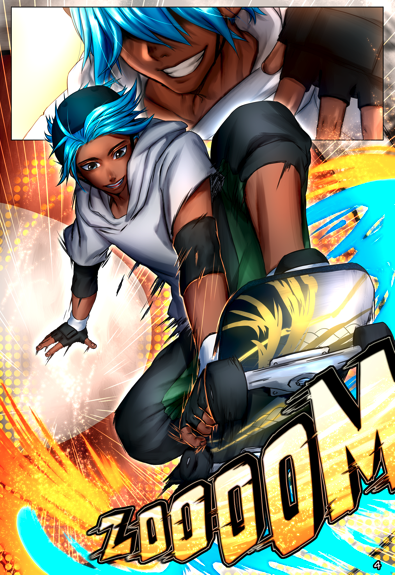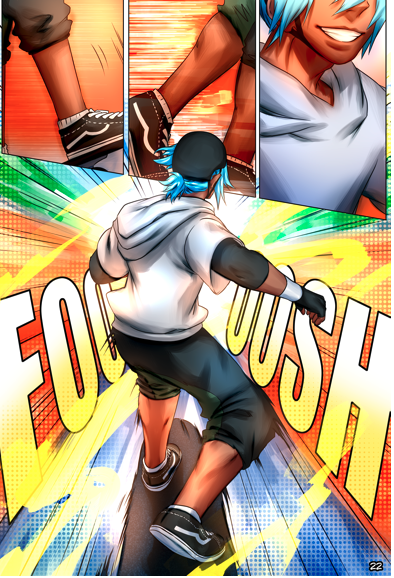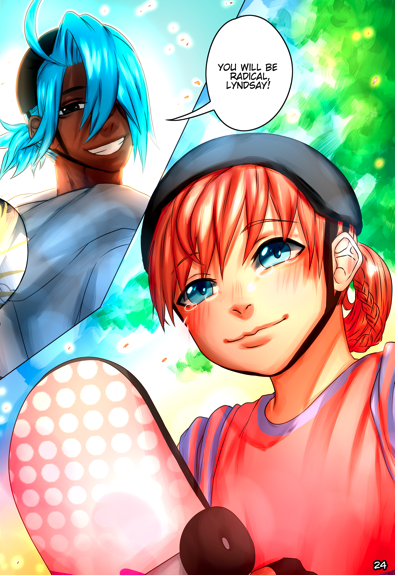Peace Kid Overview

“PEACE KID” IS A GRAPHIC NOVEL WRITTEN BY PHILIP SURACI, JR. AND ILLUSTRATED BY ENRHIYA DELOS REYES.
It is the story of Lyndsay Porter, age 12, who decides to end all warfare to protect the life of her neighbor, skateboarding teacher, and (secret) crush, Michael Pope, who has enlisted in the Marines.
With the help of her friends, she starts a campaign imploring adults to sign an Oath renouncing war. Until all adults sign the “Oath to Choose Peace,” the children will withhold all signs of affection and joy from their parents and grandparents. Through the savvy use of tech, the kids can reach every corner of the country and beyond.
Though dealing with matters of life and death, “Peace Kid” is a comedy—as flustered adults try to manage their subversive children. Kids are thrilled to knock adults back on their heels by having their parents squirm.
On the macro level, entertainment and retail plummet, putting the economy into recession. Their campaign heads to the White House, where single mom President Kristen Miller, is placed in the ultimate bind as a mother and a national leader by her own daughters. President Miller feels politically prohibited from signing such a pledge, yet as a Mom, she sincerely wants to do so. Meanwhile, her daughters act bonkers in public while telling her there’s only “one pledge per person.”


Likewise, Lyndsay faces off with her father, Max, who refuses to sign out of a conviction that the United States must always be armed and ready to act against her enemies. Max believes it is out of love (for his family) that he cannot sign. Lyndsay’s little brother, Griffin, supports the plan by refusing to say “I love you” to their mother, Sandi—who has signed the pledge.
As the tension ratchets up in the Porter household, it goes around the country. The essential theme of “Peace Kid” is “What does it mean to love someone?” “Peace Kid” unpacks this through parent/child power dynamics and a debate over the necessity of war.
The social and political views of tweens and teens are much more developed than adults give them credit. Their passion is unmatched. With the vast reach of the internet and social media, ideas can quickly travel from kid to kid without the intervention of adults.
The power of youth can be realized in unprecedented measures. Who is not familiar with Greta Thunberg in 2022? “Peace Kid” recognizes this power while honoring the validity of their sincere desire for a better world.
We think these are some of the books and best graphic novels for teens and how they relate to “Peace Kid.”
“Our House is on Fire”
—Greta Thunberg’s Call to Save the Planet” written and illustrated by Jeanette Winter. Published by Beach Lane Books.
“No one is too small to make a difference.”—Greta Thunberg
There are several books in print about Greta Thunberg, but this title is a graphic novel. Greta Thunberg, a teenager, has almost single-handedly brought the world’s attention to the perils posed by climate change as no one else before her.
Like Lyndsay Porter, the protagonist of “Peace Kid,” describes herself as “a quiet person who felt invisible.” Who “sat in the back of the classroom, not saying anything.” Until one day, her school teacher spoke of the threat posed by a warming planet to people and animals—that’s “when my life completely changed.”
Her beginnings are very much like that of our protagonist. Like Lyndsay in “Peace Kid,” Greta’s story reveals the power of one person to change the world.
2) “Drama”
written and illustrated by Raina Telgemeier. Published by Scholastic.
“Peace Kid” is a book created for the increasingly complex minds of tween and teen readers who have enjoyed the incredible catalog of Raina Telgemeier. “Drama,” in particular, is set in a middle school, as is ‘Peace Kid”— a child development laboratory overflowing with insecurity and the thrill of discovery. Comedy, romance, victory, and anguish—are keenly felt amongst the tween/teen students.
A seminal theme of “Drama” and “Peace Kid” is diversity. “Peace Kid” is intentionally comprised of an ethnically and religiously diverse group of characters.
The goal of Lyndsay and her friends is the cessation of war throughout the world. Beyond disarmament and the outlawing war, diversity is ultimately the path to a permanent end to violence. In other words, living in a world society that respects the inherent dignity of all human beings without distinction.
3) “Anne Frank’s Diary
—The Graphic Adaptation” adapted by Ari Forman, illustrations by David Polonsky. Published by Pantheon Books.
The personal dialogue of Anne with herself is the irrepressible voice of youth. Within her diary, we find the same passions felt by Lyndsay at nearly the same age: conflict with a parent, burgeoning romantic yearnings, and a fierce, uncompromising sense of justice. And, of course, the expression of disgust for the utter, immoral catastrophe that is war and its propagation.

“A person who has courage and faith will never die in misery.”
“What’s the point of war? Why, oh why, can’t people live together peacefully?”
“There’s a destructive urge in people to rage, murder, and kill. And until all of humanity, without exception, undergoes a metamorphosis, war will continue to be waged, and everything that has been carefully built up, cultivated, and grown will be cut down and destroyed, only to start again!”
—Anne Frank
4) “The Baby-Sitters Club—Kristy’s Great Idea,”
written by Ann M. Martin, illustrated by Raina Telgemeier. Published by Scholastic.
This top-rated series is filled with the energy, ingenuity, and inherent comedy that should be part of any story centering on tweens and teens—like “Peace Kid.” “The Baby-Sitters Club” also shares the themes of problem-solving through teamwork and the value of friendship.
5) “They Called Us Enemy,”
written by George Takei, illustrated by Justin Eisinger, Steven Scott, and Harmony Becker. Published by Penguin Random House.
“Peace Kid” is an American story about kids trying to end war. “They Called Us Enemy” is about an American kid who becomes a victim of war in his own country. George Takei’s harrowing memoir reveals the vast negative consequences on all citizens of warring nations, both physically and psychologically.
Significant in “Peace Kid” is the history of World War II, in particular, the Pacific War. The young soldier, whom Lyndsay wants to protect by enacting her peace campaign, is the son of a Japanese immigrant, Kumiko, and a retired African-American Marine, Ben Pope. Ben was based in Okinawa—a current vestige of America’s occupation following Japan’s defeat. In the “Peace Kid,” Kumiko shares with Lyndsay that much of her family was killed by dropping the atomic bomb on Nagasaki.
